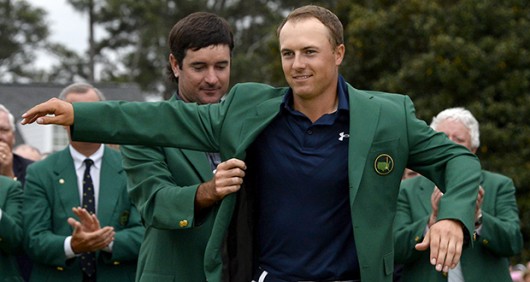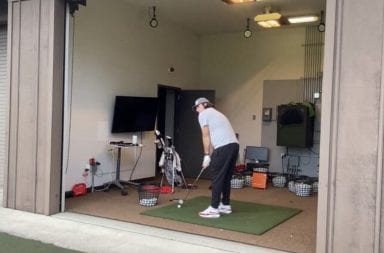
Bubba Watson (left) helps Jordan Spieth into his green jacket after Spieth won the Masters on April 12 at Augusta National Golf Club in Augusta, Ga. Credit: Courtesy of TNS
In basketball, high-end talents are dubbed the new Jordans or the new LeBrons. In soccer, young stars are named the new Messis, new Ronaldos or next Neymars. In golf, players like 21-year-old Masters champion Jordan Spieth are slapped with the tag of next Tiger.
I hate to break it to you, but there will never be another Michael Jordan, LeBron James, Lionel Messi, Cristiano Ronaldo, Neymar or Tiger Woods. Will there be more great players down the line? Of course, but the comparisons to past and current legends are a bore, and need to go away.
Like Spieth, Woods was 21 years old when he won his first major — the 1997 Masters — but nearly 20 years later, he’s not known as the new-Jack Nicklaus. Instead, he’s forged his own legacy, and can now be considered one of the greatest golfers in the history of the game with no comparisons necessary.
Spieth is certainly young, but he’s on track to build a similar legacy if he continues to progress as he has been. I’d put down good money to say that he’ll win another Masters, as well as multiple other majors.
But even if he does, how will being dubbed the next-Tiger weigh on him going forward? It might have no effect, much like Rory McIlroy — now 25 — has continued to live up to the Tiger-like hype that followed him into the professional ranks.
Spieth is already a success story to some extent when it comes to emerging from a former great’s shadow, and McIlroy certainly is. But that type of comparative hype has its darker side as well.
Ghanaian-born American soccer player Freddy Adu had it all in 2004, and he was only 14 years old. That year, he became the youngest-ever Major League Soccer player when he debuted for D.C. United, and at the same time he was dubbed the next-Pelé.
When the actual Pelé — now widely accepted as the greatest soccer player ever — was 14, he was still two years away from his debut for Santos. At 16, he was still incredibly young and already getting hype as the next great player, but many players have debuted as professionals at that age.
Almost none have played at 14.
The careers that followed are telling, as Pelé went on to score more than 600 goals for Santos along with 77 goals for the Brazilian National Team.
Adu scored 11 goals for D.C. United before moving on to Real Salt Lake, where he scored just once in 11 appearances, then onto Portuguese powerhouse Benfica, who he played for just 11 times between 2007 and 2011.
In that span, Adu spent time on loan with A.S. Monaco, Belenenses, Aris F.C. in Greece and Caykur Rizespor in Turkey. In total, he scored just six goals in 39 appearances for those teams combined.
Then Adu played 35 games for the Philadelphia Union back in MLS before playing just four for Bahia in Brazil. Then he joined FK Jagodina in Serbia, and didn’t make a single appearance.
Now in 2015, Adu is in his 11th stop as a professional with Kuopion Palloseura in Finland and he hasn’t played for the United States National Team since 2011.
Was Adu’s downfall because of the hype that followed him? Perhaps, but it’s more of a lesson of letting players forge their own legacies rather than immediately comparing them to past greats.
So don’t pine for the next Jordan and the next LeBron, and don’t compare the top young soccer prospects to Messi, Ronaldo, Neymar or Pelé. It doesn’t do any good for anyone involved.
And please, stop calling Spieth the next Tiger. Instead, just call it as it is.
Jordan Spieth is Jordan Spieth, the next great player in the game of golf.


